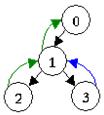PK11I - Paths in a Tree
| English | Vietnamese |
You are given a tree (a connected graph with no cycles), and the edges of the tree which are for some reason directed; your task is to add minimum number of special paths in the tree such that it's possible to go from any node to another. The rules for the special paths are noted below:
- A special path consists of some continuous edges (from the tree) and nodes.
- In a special path, the edges should be in opposite directions as they are in the tree.
- A node or an edge can be visited at most once in a special path.
- Multiple special paths may have common nodes or edges.
For example, in the picture below, a tree is drawn, the black arrows represent the edges and their directions, circles represent nodes. Then we need two special paths. One path is 2-1-0 (green arrow), another is 3-1 (blue arrow). Instead of the path 3-1 we can add 3-1-0. You cannot add a path like 1-3 or 0-1-2 because of rule 2. You cannot add 0-2 or 2-3-0 because of rule 1.

Input
Input starts with an integer T (≤ 30), denoting the number of test cases.
Each case starts with a line containing an integer N (2 ≤ N ≤ 20000), where N denotes the number of nodes. The nodes are numbered from 0 to N-1. Each of the next N-1 lines contains two integers u v (0 ≤ u, v < N, u ≠ v) meaning that there is an edge from u to v.
Output
For each case, print the case number and the minimum number of special paths required such that it's possible to go from any node to another.
Example
Input: 2 4 0 1 1 2 1 3 5 0 1 1 2 1 3 0 4 Output: Case 1: 2 Case 2: 3
| Added by: | Race with time |
| Date: | 2012-07-25 |
| Time limit: | 0.906s |
| Source limit: | 50000B |
| Memory limit: | 1536MB |
| Cluster: | Cube (Intel G860) |
| Languages: | All except: ASM64 |
| Resource: | ACM ICPC Regional Phuket 2011 |

 RSS
RSS